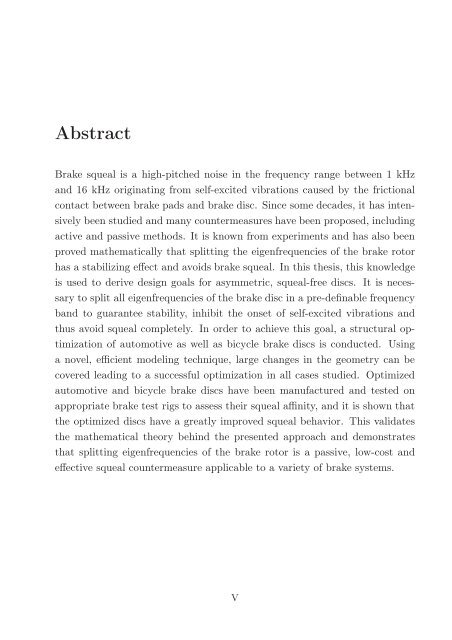Avoidance of brake squeal by a separation of the brake ... - tuprints
Avoidance of brake squeal by a separation of the brake ... - tuprints
Avoidance of brake squeal by a separation of the brake ... - tuprints
Create successful ePaper yourself
Turn your PDF publications into a flip-book with our unique Google optimized e-Paper software.
Abstract<br />
Brake <strong>squeal</strong> is a high-pitched noise in <strong>the</strong> frequency range between 1 kHz<br />
and 16 kHz originating from self-excited vibrations caused <strong>by</strong> <strong>the</strong> frictional<br />
contact between <strong>brake</strong> pads and <strong>brake</strong> disc. Since some decades, it has intensively<br />
been studied and many countermeasures have been proposed, including<br />
active and passive methods. It is known from experiments and has also been<br />
proved ma<strong>the</strong>matically that splitting <strong>the</strong> eigenfrequencies <strong>of</strong> <strong>the</strong> <strong>brake</strong> rotor<br />
has a stabilizing effect and avoids <strong>brake</strong> <strong>squeal</strong>. In this <strong>the</strong>sis, this knowledge<br />
is used to derive design goals for asymmetric, <strong>squeal</strong>-free discs. It is necessary<br />
to split all eigenfrequencies <strong>of</strong> <strong>the</strong> <strong>brake</strong> disc in a pre-definable frequency<br />
band to guarantee stability, inhibit <strong>the</strong> onset <strong>of</strong> self-excited vibrations and<br />
thus avoid <strong>squeal</strong> completely. In order to achieve this goal, a structural optimization<br />
<strong>of</strong> automotive as well as bicycle <strong>brake</strong> discs is conducted. Using<br />
a novel, efficient modeling technique, large changes in <strong>the</strong> geometry can be<br />
covered leading to a successful optimization in all cases studied. Optimized<br />
automotive and bicycle <strong>brake</strong> discs have been manufactured and tested on<br />
appropriate <strong>brake</strong> test rigs to assess <strong>the</strong>ir <strong>squeal</strong> affinity, and it is shown that<br />
<strong>the</strong> optimized discs have a greatly improved <strong>squeal</strong> behavior. This validates<br />
<strong>the</strong> ma<strong>the</strong>matical <strong>the</strong>ory behind <strong>the</strong> presented approach and demonstrates<br />
that splitting eigenfrequencies <strong>of</strong> <strong>the</strong> <strong>brake</strong> rotor is a passive, low-cost and<br />
effective <strong>squeal</strong> countermeasure applicable to a variety <strong>of</strong> <strong>brake</strong> systems.<br />
V

















